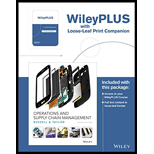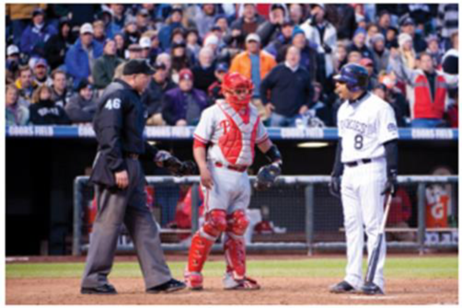
Concept explainers
It used to be that major league baseball (MLB) umpires were scheduled on an Excel spreadsheet. The task took several weeks and had to be revised often. Now they use a scheduling system developed by researchers at the University of Miami, Carnegie Mellon, and Michigan State University. A variant of the classic Traveling Salesman problem, umpires, as shown in the photo, are assigned to crews that must visit all ballparks at least once during the year. Of course, there are many more constraints.

Perspectives/Jeff Smith/Shutterstock
MLB teams play 2430 games in a two- to four-game series during a six-month season. Each game requires a crew of four umpires. There are currently 70 umpires on MLB staff, and 22 AAA umpires who may be called up as needed to fill in for games. A typical umpire will handle 142 games a year. Unlike football referees, umpires are full-time employees of MLB. Umpires are normally assigned to crews, but the content of these crews can change during the year. Constraints to umpire crew scheduling include mandated vacations, overexposure to individual teams, prohibition to refereeing at home, and minimizing coast-to-coast travel. Examples of MLB rules used to enforce these constraints are:
- Crews should travel to all 30 ballparks at least once during a season.
- Crews should not umpire the same team’s series of games more than once every 18 days.
- Crews must not travel from the West Coast to the East Coast without an intermediate day off.
- Crews must not umpire consecutive series more than 1700 miles apart without an intermediate day off.
- Crews must not travel more than 300 miles preceding a series whose first game is a day game.
- Crews should not work more than 21 days without a day off.
- Crews should see each team at home and on the road at least once.
- Crews should have balanced schedules (i.e., travel approximately the same number of miles, umpire the same number of games, and have the same number of days off).
Real-life scheduling problems, like umpire scheduling, can be quite complex. The general solution approach is similar to the assignment method of linear programming described in this chapter. There is an objective function of minimizing distance traveled subject to a number of constraints, as listed earlier. The variables are (0,1) meaning an umpire is either assigned to a game slot (i.e., 1), or not (i.e., 0), and the game slots are numerous (2430 × 4 = 9720). While this can be solved as an integer linear programming (LP) problem, the length of time to do so and the inability to relax constraints make it difficult to find a feasible solution.
Academics use heuristics, or rules of thumb, to solve these types of problems. Heuristics do not necessarily satisfy all constraints and do not guarantee an optimal solution, but they can give satisficing or “good enough” solutions. The heuristics are evaluated against performance metrics, previous solutions, and “optimal” solutions (from mathematical programming such as LP). The heuristics are usually improved on with use until users accept them. Many are then coded into software and sold as scheduling systems for particular applications.
Approximate the number of possible solutions for this problem. With computer systems able to process huge amounts of data quickly, would it be possible to enumerate all possible schedules and choose the best? Investigate.
Want to see the full answer?
Check out a sample textbook solution
Chapter 17 Solutions
Operations and Supply Chain Management, 9th Edition WileyPLUS Registration Card + Loose-leaf Print Companion
Additional Business Textbook Solutions
Financial Accounting: Tools for Business Decision Making, 8th Edition
Corporate Finance (4th Edition) (Pearson Series in Finance) - Standalone book
Auditing And Assurance Services
Essentials of Corporate Finance (Mcgraw-hill/Irwin Series in Finance, Insurance, and Real Estate)
Marketing: An Introduction (13th Edition)
Principles Of Taxation For Business And Investment Planning 2020 Edition
- Not use ai pleasearrow_forwardWhat is Bitcoin? How important is it to businesses and individuals? How does it cause environmental damage and is that damage worth continued uses of Bitcoin? Read the following articles to help answer these questions: United Nations University. (2023, October 24). UN study reveals the hidden environmental impacts of bitcoin: Carbon is not the only harmful by-product. https://unu.edu/press-release/un-study-reveals-hidden-environmental-impacts-bitcoin-carbon-not-only-harmful-product#:~:text=Bitcoin%2C%20the%20most%20popular%20cryptocurrency,the%20worldwide%20Bitcoin%20mining%20network. Salam, E. (2023, April 26). Bitcoin is terrible for the environment – can it ever go green? The Guardian. https://www.theguardian.com/technology/2023/apr/26/bitcoin-mining-climate-crisis-environmental-impactarrow_forward419 X .com/courses/1546/assignments/49499?module_item_id=111573 Unlimited Attempts Allowed ✓ Details Directions: Record a video of yourself giving a business presentation. Imagine you are tasked with researching a professional development topic on business communication for 40 coworkers. You are then expected to give a 4 - 5 minute presentation on the topic. Choose any topic related to business communication, such as intercultural communication, effective leadership, professional writing, etc. Research the topic and prepare a 4 - 5 minute presentation that could be given over video conference call (such as Zoom). You may use visual aids if you choose. Upload a video file of your presentation. Provide all needed citations. Requirements: 4-5 minutes long Contains visual and audio Create your own work; do not plagiarize Cite your sources using APA citations Choose a submission type Tarrow_forward
- acts Container chips (s 150 cussion: Conflict X + e.com/courses/1546/discussion_topics/15722?module_item_id=111559 24 Winter > Discussions > Week 8 Discussion: Conflict 时☆ 26 Replies, 26 Unread Week 8 Discussion: Conflict Write a 200 - 300 word discussion post based on the prompt below. Reply to at least one other student in 50 - 100 words. Can you think of a time when a conflict led to a new opportunity, better understanding, or other positive result? If not, think of a past conflict and imagine a positive outcome. Discuss the impact of this conflict on your workplace relationships, productivity, and innovation. Source: Business Communication for Success. (2015). University of Minnesota Libraries Publishing. Attribution-NonCommerical-ShareAlike. Edit View Insert Format Tools Table 12ptv Paragraph BIUA T2arrow_forwardHow would you design and implement a modern networking solution for JAMS Manufacturing to connect all their facilities and ensure seamless communication? The company currently has standalone systems in three manufacturing plants and an office building, each using its own modem or router for internet access. The goal is to create private networks for each location, connect them to one another, and provide Internet access to all. You’ll need to consider factors like new computer systems, servers, and telecommunications wiring, and explain how your solution will benefit the company and how it will be implemented effectively.arrow_forwardIdentify specific performance management processes covered in this course and how each aligns with an elements of LaFevor’s HCMS Model.arrow_forward
- Identify specific performance management processes covered in this course and how each aligns with LaFevor’s HCMS Model. LaFevor, K. (2017). What’s in Your Human Capital Management Strategy? The Game Plan, the Path, and Achievingarrow_forwardassess how Human Capital Management Strategy is aimed at building an effective integrated performance management system: Discuss how human capital management strategy relates to performance management.arrow_forwardCASE STUDY 9-1 Was Robert Eaton a Good Performance Management Leader? R obert Eaton was CEO and chairman of Chrys- ler from 1993 to 1998, replacing Lee Iacocca, who retired after serving in this capacity since 1978. Eaton then served as cochairman of the newly merged DaimlerChrysler organization from 1998 to 2000. In fact, Eaton was responsible for the sale of Chrysler Corporation to Daimler-Benz, thereby creating DaimlerChrysler. With 362,100 employees, DaimlerChrysler had achieved revenues of €136.4 billion in 2003. DaimlerChrysler's passenger car brands included Maybach, Mercedes-Benz, Chrysler, Jeep, Dodge, and Smart. Commercial vehicle brands included Mercedes-Benz, Freightliner, Sterling, Western Star, and Setra. From the beginning of his tenure as CEO, Eaton communicated with the people under him. He immediately shared his plans for the future with his top four executives, and upon the advice of his colleague, Bob Lutz, decided to look around the company before making any hasty…arrow_forward
- Critically assess Martin’s coaching style.arrow_forwardCompare Robert Eaton’s performance management leadership presented in the case against the performance management leadership principles, functions, and behaviors. What recommendations can be made about what he might do more effectively? Explain and defend your answer.arrow_forwardIn the context of the material in Chapter 9, provide a critical analysis of the decisions that Henry has made in assigning Martin to this role.arrow_forward
 Practical Management ScienceOperations ManagementISBN:9781337406659Author:WINSTON, Wayne L.Publisher:Cengage,
Practical Management ScienceOperations ManagementISBN:9781337406659Author:WINSTON, Wayne L.Publisher:Cengage, Purchasing and Supply Chain ManagementOperations ManagementISBN:9781285869681Author:Robert M. Monczka, Robert B. Handfield, Larry C. Giunipero, James L. PattersonPublisher:Cengage Learning
Purchasing and Supply Chain ManagementOperations ManagementISBN:9781285869681Author:Robert M. Monczka, Robert B. Handfield, Larry C. Giunipero, James L. PattersonPublisher:Cengage Learning


